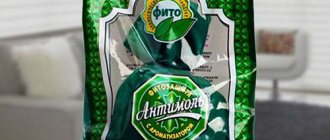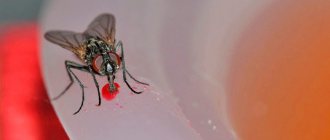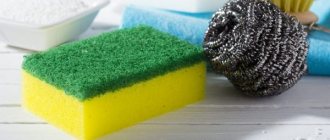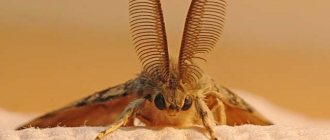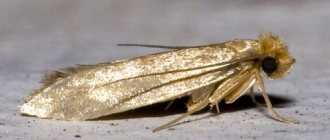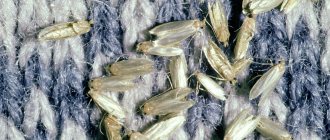Moths are one of the most annoying and difficult pests to remove. Any moth repellent will not be effective without general cleaning. To get rid of it, you need to destroy all oviposition. Various means are used for processing: plates, sprays, solutions of vinegar and ammonia. And to prevent re-infection, sticks, balls and sprigs of herbs are placed in the cabinets.
Types of moth larvae
To figure out what a moth larva looks like, you need to find out what type it belongs to. Experts identify several types of these pests:
- Clothes - eats felt, wool, felt and other fabrics;
- Furniture – feeds on upholstery of upholstered furniture;
- Carpet - can greatly damage carpets, paths, rugs;
- Fur coat - prefers fur;
- Kitchen - found in grains (barley, rye or wheat), often spoils dried fruits, seeds, berries, nuts and seeds.
The main difference between these individuals is precisely their preferred habitat - the clothes moth larva will not settle in cereals, grain or flour, and the kitchen caterpillar will never gnaw through clothing or textiles.
In appearance, these larvae are almost identical - they are small white or yellowish caterpillars with a brown head and clearly visible gnawing jaws. Most moth larvae are worm-like and have 6 pairs of legs. Photos will help you verify this.
The larvae can also be recognized by the structure of their “house”. Thus, the caterpillars of fur coat, carpet and clothes moths make a small cocoon from the remains of damaged textiles and a silk-like substance and put it on themselves. In this form, they are even able to move short distances. As for the larvae of furniture and kitchen moths, they create tunnels from food scraps, silk and excrement.
Moths are an invisible but insidious enemy. In a very short time, your fur coat may become unwearable.
Having recognized the pupa by its appearance, you will be able to choose effective means to destroy these pests.
Features of food (grain) moths
The cream-colored worms that sometimes spoil flour, cereals, breadcrumbs, dry kvass, and oatmeal are the larvae of food or grain moths. Caterpillars eat grain, gnawing a tunnel in it. As a result, the product turns out to be completely spoiled - in addition to the larvae themselves, it contains excrement, eggs and their shells, as well as cocoons made from food waste, inside which the pupae sit.
At first, the eggs laid have a white shell, then they turn noticeably yellow. Newly hatched larvae are reddish in color, but become creamy as they mature. Their length rarely exceeds a centimeter.
If you look at a photo of a food pest larva taken with a magnifying device, you will see a whitish caterpillar with a smooth body, whose transverse segments and dark head are clearly visible. The legs that extend from the abdomen are underdeveloped in the larvae, but the gnawing apparatus is well developed, with the help of which the caterpillar bites into the hard body of cereals.
The eggs and larvae of the grain pest are afraid of temperature fluctuations.
- When heated above 60ºC, the egg clutch dies within 5 minutes, the larvae themselves die after an hour or an hour and a half.
- Freezing moth-infested products is slower compared to heating - when the temperature drops to -10ºC, death occurs after 3 days.
Note! The discovery of cobwebs in the product indicates the presence of mature pupae, from which moths ready to fly will soon emerge, which will give a new twist to the problem of how to remove food moths and their larvae. Therefore, it’s time to start disinfecting products and premises from the pest.
Clothes room or room
Clothes or indoor moths are the most fierce enemy of beautiful and expensive things; their larvae damage and deteriorate your favorite sweaters, warm socks and mittens, cozy shawls, scarves, blankets and upholstered furniture. All those fabrics and things that contain wool, silk, down or fur are at risk of being damaged by a clothes pest.
The peculiarity of the clothes pest is the desire of the females to burrow deeper into the folds of the fabric and lay eggs there, and worms will subsequently emerge from it, leaving behind ugly holes everywhere.
The search for caterpillars swarming in things should be carried out immediately as soon as a red butterfly fluttering in the room is noticed - there is probably already a habitat or egg clutch somewhere.
A scattering of tiny, up to 0.5 mm long, milky-colored eggs should be looked for in the hidden folds of clothes put away for storage that have not been taken out of the closet for a long time - things that are regularly worn are not suitable as a breeding ground for moths. The indoor pest especially loves dampness, which is where it prefers to leave its eggs.
Having discovered a cluster of caterpillars on an item of clothing or household items, as well as the holes they have made, you can assess the extent of the damage and at the same time find out what a clothes moth larva looks like.
- The caterpillars of the clothing-eating moth are much more transparent than the grain moth, from the moment they emerge from the egg they are about 1 mm long and milky in color, but due to the translucent abdomen, its darkening contents can be easily seen.
- The body is smooth, with clearly distinguishable segments.
- The head is brownish, dark, equipped with powerful gnawing jaws and salivary glands, from the secretion of which the clothes moth larva builds a cocoon for itself.
- Before pupation, the larva grows to one and a half centimeters.
The clothes moth's cocoon is obtained from a secretion that instantly hardens in air, which is a silk thread. It is hard to the touch and resembles the shape of a tiny spindle. After maturation, the actively flying males emerge from its shell first, and later the females, who fly poorly and rarely.
This is interesting! Initially, clothes pest moths enter people's homes by flying from the street to a light source in the dark.
Tips to help get rid of the pest:
Features of the fur pest
The moth, whose caterpillar “specializes” in furs, cuts off the lint on fur coats, fur collars and hats, leaving extensive bald spots, which renders expensive items unusable. Fur-lined shoes and mittens, as well as vests and other items with fur elements, can also become victims of the voracious house moth larvae.
A characteristic feature of the larvae of the fur pest is the presence of a kind of “house”, reminiscent of a cover made of clipped fur fibers. The larva moves with it, hiding inside it if necessary.
Remember! Fur moth larvae are especially harmful - they shear fur non-stop, regardless of whether the fibers are used for food or not, so they should be identified and exterminated urgently!
The body of the house moth larva is whitish, naked, translucent, the legs are poorly developed. The head is brown-brown in color with an excellently developed gnawing mouth. And adult moths differ from other moths by the presence of dark dots on their wings.
Stages of development of moth larvae
The pupa goes through 4 stages of moth development (or 4 molts). The timing of each stage is individual for each species and largely depends on living conditions. The ideal temperature for the development of caterpillars is +23-25 degrees. In this case, the development of the larva lasts up to 90 days, and the total cycle from egg to egg is about 6 months. When the air temperature rises to +30 degrees, this period is reduced to 60 days; when the air temperature drops to +13 degrees, it increases to 190 days. If the room is too cold (below +13 degrees) or too hot (above +30 degrees), the pupae will simply die.
Interestingly, food moth larvae develop much faster than other species. The higher nutritional value of food helps them in this. Coming out of the cocoon, the butterfly goes in search of a sexual partner. The male dies after mating, the female - after laying offspring.
Interesting! An adult moth does not have a mouthpart, so it cannot harm clothing. Having turned into a butterfly, this insect stops feeding altogether - nature deprives it of such an opportunity! The main danger of butterflies is their ability to lay eggs, from which offspring appear very quickly. Each new doll means a couple of new bald spots in a hat, sweater and fur coat.
The caterpillars of this domestic insect are characterized by low mobility - they rarely move long distances. Taking care of her offspring, the female lays eggs (from 30 to 200 pieces) either directly on the food or close to it. Literally after 5-10 days, microscopic larvae appear from them.
Reviews
Below are reviews of some moth control products from people who have already tried them in practice and are now ready to share their impressions:
- Elizabeth: “I never paid any attention to the fact that moths were sometimes found at home until I bought myself an expensive fur coat. I immediately purchased hanging plates called “Clean House”; the signs of moths disappeared within a week. The instructions said that they would be valid for three years; if this is indeed the case, then “Clean House” is a very high-quality product at a low price.”
- Mikhail: “I tried to use Raid paper pendants against moths, they really help, but the smell is such that I don’t know what’s worse - the insects or the anti-moth product. I bought similar products from Raptor, the aroma is much more pleasant, it smells like fresh oranges, and it helps just as well.”
- Svetlana: “This year, for the first time in my life, I encountered the problem of food moths. Because of her, we had to throw away a significant amount of supplies of spices, seasonings, cereals and nuts, since, apparently, she eats absolutely everything. For hatching I used Raptor traps, then Aeroxon. The effect of both options is equally positive; I refused Raptor only because its adhesive strip was too narrow, which created some difficulties during use.”
What do moth pupae eat?
Moth caterpillars eat a wide variety of things and foods. If in nature they eat bird feathers, animal hair, nuts, vegetables, grains, berries and fruits, then in an apartment their menu becomes much richer. This list includes furs, fabrics made from cotton, silk, flax, wool, as well as human hair. The main thing is that the materials are natural and old - they are easier to chew and digest. Parasites are especially attracted to clothes soaked in sweat and carpets with liquid spilled on them. In such places, the larvae receive not only food, but also water.
Among the food products moth pupae prefer:
- Muke;
- Bran;
- Mahnke;
- Krupam;
- Liver;
- Nuts;
- Seeds;
- Dried fruits;
- Tea;
- Candy;
- Pasta.
Of course, the caterpillar's stomach is not capable of accepting large amounts of food. She eats very little, so small damage can go unnoticed for a long time. The problem is that there are a huge number of pupae in the brood. After such a feast, things or food will simply have to be thrown away.
Where to look for moth larvae?
House moths avoid brightly lit places. Only some females pupate in the open. The permanent place of residence of these pests depends entirely on the species. So, clothes moths should be looked for in the clothes closet, and kitchen moths should be looked for in cabinets where food supplies are stored.
If you see a gray butterfly in your apartment, you can be sure that its larvae have already begun to damage things and food supplies. There are also a number of signs indicating the presence of pests.
Kitchen moth:
- Banks and bags of food are covered with a thin cobweb;
- Tunnels appear in sweets, in which larval secretions can be seen;
- Inside the cabinets and on the ceiling (in the corners) there are cocoons with pupae hanging;
- There are traces of molting;
- Spoiled grains are increasingly found in cereals;
- In the flour you can find stuck together lumps with worms inside.
Contaminated foods should not be eaten as chitinous shells, excrement or dead larvae may remain in them. After eating such a mix, you risk getting poisoned or getting an allergy.
Clothes, fur and furniture moths:
- Bald patches appear on carpets;
- In the cabinets there are cocoons with caterpillars;
- Large pellets are visible on furniture upholstery and clothing, with larvae hidden inside;
- Through holes appear on things;
- The fur near the base appears to have been trimmed with scissors.
Methods for destroying moth larvae
How to deal with moth larvae? This is a rather complex process that requires care and strict adherence to all instructions. It goes through several stages.
Step 1: Remove all clothes and bedding from your closets and check them thoroughly. Don't be lazy to shake everything up! The fact is that moth caterpillars do not adhere well to the surface, so if actively shaken, they will fall to the floor. It is better to throw away hopelessly damaged and very old clothes so as not to provoke pests to new attacks.
Step 2. Take the infected items out into the sun and warm them thoroughly. The main condition is that the air temperature outside must exceed +30 degrees.
To save things from moth larvae, just take them outside in the summer and thoroughly “fry” them in the sun.
Step 3. If the moth infestation occurs during the winter, place the clothes in the washing machine and wash them on the highest setting (above 50 degrees). Hot water helps destroy the eggs and larvae of not only moths, but also other parasites. The washing cycle should be at least half an hour.
Step 4. Try freezing what cannot be washed. Pack your items in a clean bag and place it in the freezer or outside for 24 hours. True, after freezing the clothes will still have to be at least rinsed.
Step 5: Clean the infected areas. First, the cabinets are vacuumed and then wiped with a damp cloth soaked in hot water with the addition of cleaning gel. Pay special attention to distant dark corners.
Step 6. To be safe, spray all surfaces with a disinfectant solution, insecticidal aerosol (Antimol, Armol, Raptor) or spray (Supromit, Suprozol, Neofos sprays). Treat clothes, carpets and furniture upholstery with the same products.
Step 7. Pack the items cleared of larvae into plastic bags. Special vacuum packaging is best suited for these purposes. If any individual survives the purge, it will not be able to survive without access to food.
Step 8. Place moth prevention products in your closet. This may be the old, proven naphthalene or newer preparations in the form of sections, fumigators and tablets (“Antimol” or “Prayer”). They are impregnated with an insecticide, which, when evaporated, creates unfavorable conditions for the development of larvae and the life activity of adults. An alternative to them will be special balls made from cedar wood. They contain essential oil that kills small moth pupae. They are no longer effective against large caterpillars. If desired, you can use bouquets of dried lavender or any ether that has a strong aroma.
Folk remedies
And finally, you should find out how to remove moths using traditional methods. All the tools and techniques that will be described below do not involve the use of any chemicals, are available to everyone and are inexpensive. However, at the same time, it is quite problematic to destroy moths with their help; they are intended rather to repel insects. For this reason, to achieve a positive result, they should be used to combat parasites in combination with more powerful modern drugs.
- Essential oils. For moths, the smells of essential oils such as orange, geranium and lavender are repulsive. They need to soak cotton pads and place them in places where moths accumulate.
- Repellent plants. Dried geranium or lavender herbs are tied in bunches and hung in the closet.
- You can use scented toilet soap as a deterrent.
- Newspaper helps against moths. They wrap or rearrange things in it and leave them in the closet. However, this method is not suitable for light fabrics and fur products.
As you know, taking preventative measures is always easier than fighting moths afterwards. Therefore, do not forget to regularly ventilate your closet, clean fur and woolen items, and shake out items on shelves and hangers from time to time.
How to protect fur from moths?
To preserve your fur treasure for many years, listen to the advice of experienced moth fighters.
Tip 1. At the end of the winter season, your fur coat should be thoroughly cleaned with a clothes brush.
Tip 2. It is recommended to store fur products in special tightly closing cases. As a rule, they come complete with high-quality and expensive fur coats.
Tip 3. Wrap the hats in clean newspaper and place them in a box with a tight lid.
Tip 4. At least once a month, take your fur coat outside or onto the balcony and keep it there all day - moths do not like bright light and will rush to find more favorable living conditions. As for the larvae, they will die immediately.
Tip 5. This pest does not tolerate sudden changes in temperature and hates the cold. There are special refrigeration units for storing fur coats. If possible, buy yourself one.
Tip 6. From time to time, open the closets in which winter clothes are stored for ventilation. This should be done at least once a month.
Tip 7. Place a moth repellent next to your fur item and change it every 3-6 months. Such devices have an unpleasant odor, but reliably destroy the larvae. After using them, clothes must be well ventilated.
Tip 8. Fragrant soap will also help save your fur coat from moth larvae. Take it out of the packaging and put it in your pockets - its strong smell will repel any insects. Tobacco leaves, citrus peels and geranium branches have a similar property. They will have to be changed more often, because these products quickly erode.
Using garment covers
Covers for clothes, made of fabric with special insecticidal impregnation, are an additional means of protecting expensive clothing from flying pests. The duration of use of such a cover is 1 year, however, experts recommend renewing the impregnation of the cover every 3 months, using a special poison for this.
Special cases for storing clothes.
When choosing a moth cover, it is better to give preference to one that matches the size of the product, is made of dense, light-proof fabric with a texture that allows the fur to “breathe” freely.
How to remove kitchen moths?
The larvae of house moths that live in the kitchen are hatched differently. Everything is much more complicated here!
How to destroy kitchen moths in an apartment, read more in this article.
- Empty kitchen cabinets;
- Vacuum them thoroughly using special narrow nozzles - they will allow you to reach hard-to-reach places;
- Clean the “insides” of the cabinets with a brush, dipping it in hot water with added detergent;
- Spray the shelves with a vinegar solution and wipe off the liquid with a sponge. This will destroy caterpillars and moth eggs. Vinegar can be replaced with liquid bleach. Dilute it with water 1:4, pour into a container with a spray bottle and use for spraying. Bleach contains chlorine, so be very careful not to get it in your eyes, nose or mouth. Its contact with places where food is stored can also be dangerous. After treatment, thoroughly wash the furniture with clean water and make sure that no traces remain on its surface;
- Conduct an audit of food supplies. The bag in which the moth began to breed must be tightly tied and carefully taken out into the trash. It is also better to throw away contaminated products - they can become a source of repeated troubles. Unopened packages can be safely left behind;
- Have you noticed any moth larvae and have no intention of getting rid of your supplies? Fry them in the oven at 60 degrees or put them in the microwave for 5-7 minutes. If heat treatment is not possible, freeze within a week;
- Wash food containers in the dishwasher or very hot soapy water. Then they need to be rinsed with vinegar.
Be very careful - an undetected pupa or a butterfly left alive can reinfect your apartment. Also remember not to use chemical insecticides in the kitchen.
You need to know this: 5 tips on how to get rid of food moths in the kitchen at home!
Contact specialists
Specialized companies provide services for the destruction of moths in houses, apartments, retail, office and warehouse premises. Treatment is carried out using the cold or hot fog method.
Treatment of the room with cold fog.
Cold fog is an aerosol spray of an insecticidal composition with a temperature equal to the ambient temperature.
It stays in the air for no more than 4 hours and is suitable for treating rooms where animals or plants are located.
Hot fog is a spray of a product with a temperature of about 60°C. Its hovering in the air lasts about 10 hours; this option is used to kill moths in greenhouses or non-residential premises.
Preventing moths
The best way to prevent moths from entering a room and its further reproduction is to carefully check the products purchased and regularly wash things. Other methods of combating these universal pests, capable of living on very meager rations, have not yet been found. Also take note of a couple of useful points:
- Do not buy products for more than 7 days;
- Store food in tightly sealed containers;
- Subject purchased flour and cereals to mandatory heat treatment;
- Place fine-mesh mesh on the ventilation ducts;
- Shake purchased clothes well outside and wash them.
